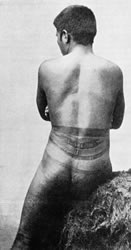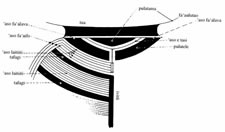Embodied Symbols of the South Seas: Eastern Oceania
Article © 2010 Lars Krutak
Introduction to Polynesia
The Pacific Ocean covers one-third of the planet and washes the shores of numerous island chains including Polynesia that literally means "many islands." Roughly speaking, the geographical area of Polynesia forms a nearly perfect triangle defined by Hawaii at the northern tip supported by its two bases: New Zealand at the western edge and Easter Island at the eastern boundary.
|
|
When the first Europeans arrived on the beaches of Polynesia in the late 16th century, the islands were home to some 500,000 people descended from the great seafaring Lapitas who reached Fiji, Tonga, and Samoa by at least 1100 B.C., if not earlier. Over time, the inhabitants of Polynesia not only became farmers, fishermen, seafaring merchants, and artisans; they also developed complex political and religious institutions where obedience to chiefs, royal families, priests, ancestors, and the gods was part of everyday existence. |
From a religious perspective, however, Polynesian peoples shared a widespread belief that the universe was governed by invisible forces that could determine, influence, and control the events of life and human destiny itself. This mystical relationship was forged by the actions of a large number of patron deities that held sway over daily activities such as agriculture, fishing, navigation, warfare, and the creation of art forms including tattoo, while more "personal" gods watched over individuals, families, and local communities. All of these entities were propitiated with offerings and sacrifices and they were ritually honored in temples and other sacred locations to keep their favor close to the living.
Although priests had the power to directly communicate with these important divinities, so too did expert artisans - albeit in a different way. Properly apprenticed craftsmen like tattoo artists not only worked under the protection of one or more patron deities, but they also had the ability to control the supernatural force of mana that was distributed in natural objects and substances as well as subjects like their human clients. Mana was believed to have had an influence on all the achievements and abilities of humans, but it embodied living bodies differentially - some individuals possessed more than others.
Mana could be acquired through inheritance, or it could be accumulated through ritual performances and proper patterns of behavior. It could also be transmitted through vehicles like tattoos, but mana could also be lost out of ignorance or even death at the hands of an enemy.
Obviously, the more mana an individual artisan possessed, the more powerful he was, and tattoo artists were no exception to this rule. The most accomplished skin artists endured a long apprenticeship to a practicing craftsman, and they could demonstrate a genealogical relationship to a former master. Tattooists also maintained a vast repertoire of rituals, chants, and mythological stories. These were employed as he laid down tattoo designs on his client's skin to give them their initial layer of mana. As he spent more time executing the bold and intricate designs, additional layers of mana permeated the markings with his words and actions, in turn fortifying the tattoo recipient.
|
 |
 |
Samoan pe'a tattooing, ca. 1900. |
Framework of Samoan tattooing patterns for the back, ca. 1900 |
Mana was recognized in individuals by their position, genealogy, skills, reputation, and influence. Some individuals were almost godlike because they possessed so much mana. But there was a necessary compliment to mana, a force called tapu that held it in oppositional check. Tapu consisted of a series of restrictions and taboos, as well as customary behaviors and actions, that were to be approached with extreme caution or completely avoided in order to protect one's mana. Great personages such as chiefs and his offspring, priests, and tattoo artists could possess a great amount of tapu because of their shared identity (or proximity) with the divine, but this depleting energy of "contagious sacredness" was also manifest in other people, animals, and especially substances like blood and food that either flowed out of or entered the body.
Polynesians viewed the human body as a kind of ritual container that was composed of a suite of substances derived from the po, an indigenous concept symbolically related to darkness, death, fertility, and the realm of the gods. It was surrounded by the ao: the world of the living and light. Because po was believed to exist within the body, the body's orifices and natural substances like blood were considered to be potential passageways into this sacred realm.
By virtue of their profession, tattooists across Polynesia were constantly confronted with tapu. On one level, the act of artistic creation was considered sacred and tapu itself because of the bloodletting that ensued. Furthermore, as tattooists called upon their patron deities during their work, they summoned them from their homes in the world of darkness (po); in turn, they rendered their activities, immediate surroundings, and patients tapu. Moreover, tattooists did not usually tattoo just any man or woman. Tattooing was an expensive undertaking typically reserved for chiefs, warriors, and other nobles who could afford it. And because these individuals possessed the greatest concentration of mana in the community, the tattoo artist was exposed to their tapu whenever he plied his instruments. Of course, if a tattooist or anyone else ignored the ritual restrictions or came into personal contact with a tabooed subject, place, or object without tapu removal, they risked severe injury and even death.
Notwithstanding such ritual constraints and dangers, the elaborate and sophisticated designs produced by Polynesian tattoo masters are some of the most incredible artistic endeavors to be created in any medium worldwide. Aside from such visual and aesthetic considerations, however, most of our knowledge of Polynesian tattoo culture as it existed in the pre-contact and early historical periods is based on the observations of Westerners who, for a variety of reasons, sought to understand and abolish it (e.g., missionaries) at the same time. Although this documentary evidence is necessarily shaped by the imperfect perspectives and biases of non-indigenous foreigners, their testimony offers one of the only windows into this largely vanished world; a world that I will attempt to uncover in the following pages of this article.
Next Page | 1
|
2 |
3 |
4 |
5 |
6 |
7 |
8 |
Museum photo gallery of the images
on this page may be seen here. |


